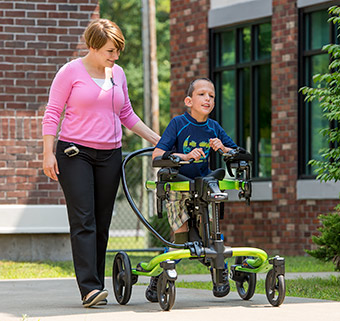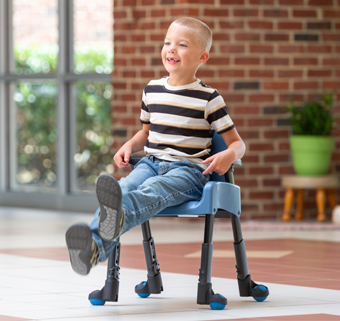The School-Based Team: Fostering Therapist-Teacher Collaboration
| September 2024 A collaborative team approach is best practice in a school-based setting for students with disabilities.1-5 Educators, classroom staff, related service providers like speech, OT, and PT, families and the students themselves are all valuable members of this team. Each member plays a different role and contributes an area of expertise and perspective. Research shows that a thriving school-based team enhances student outcomes, promoting the well-being and function of the student in the educational setting.1,4,6,7
A collaborative team approach is best practice in a school-based setting for students with disabilities.1-5 Educators, classroom staff, related service providers like speech, OT, and PT, families and the students themselves are all valuable members of this team. Each member plays a different role and contributes an area of expertise and perspective. Research shows that a thriving school-based team enhances student outcomes, promoting the well-being and function of the student in the educational setting.1,4,6,7
In the classroom, educators and support staff spend the majority of time with the student. They are the ones juggling a child’s schedule and implementing the interventions and positioning recommendations of the team into daily routines to meet the student’s educational goals. In one survey, 96% of school-based therapists reported not being present during the implementation of equipment positioning programs. The classroom teacher, aide or personal assistant completed the transfers and positioning tasks for the student most of the time.8 For this reason, collaboration between the therapist and teacher is key.4-7, 9-11 If classroom staff do not feel adequately trained or equipped to position a student, do not have the time, or do not fully understand the purpose of the intervention, it is less likely the intervention will take place.5,6,9 By providing the training and resources to empower classroom staff to position students effectively, therapists can increase the likelihood that therapeutic interventions will take place.6,7,9
According to the competencies for a school-based therapist, the therapist’s role is to act as a consultant to the educators and families, providing recommendations for interventions, positioning and equipment use.2 Rather than seeing the therapist as an “expert,” a collaborative approach allows team members to “share their unique knowledge, expertise, and skills to identify and address the needs of the students.”1 In a therapist-to-teacher collaboration, knowledge sharing can take a variety of forms. Some of these include direct instruction or demonstration of transfers or positioning techniques for a specific student, or working together to navigate a child’s schedule to identify intervention opportunities. Other forms include providing education about the roles and services offered by different team members or why a certain intervention is important.4,9 Finally, knowledge sharing includes the provision of written resources and checklists to ensure each child has the supports and accessories they need to complete an activity or maintain comfort in adaptive equipment.9 Although the majority of school-based teams agree with the importance of knowledge sharing, a recent survey reports that this is happening less than 50% of the time.9
According to the motor learning principle of practice/repetition, the more opportunity a child has to practice a skill or participate in an upright or mobile position, the higher the likelihood of the child acquiring and retaining the skill.12 A school-based team recognizes that the teachers are instrumental in structuring the student’s daily routine. Continued dialogue and knowledge sharing between the different team members increases opportunities for a child to participate and supports the daily implementations of recommended interventions to meet the student’s educational goals.
Rifton Resources to Promote School-Based Therapist and Teacher Collaboration
Below are a few adaptive equipment-related resources for the school-based team.
Positioning Checklists – These Rifton product positioning checklists allow school-based practitioners to detail the exact product features and supports needed for a child, which can be a useful reference for classroom staff.
- Positioning Checklist for the Rifton Activity Chair
- Positioning Checklist for the Rifton Stander Size 1
- Positioning Checklist for the Rifton Stander Size 2
- Positioning Checklist for the Rifton Dynamic Pacer
- Positioning Checklist for the Rifton E-Pacer
- Positioning Checklist for the Rifton TRAM
- Positioning Checklist for the Rifton Mobile Stander
- Positioning Checklist for the Rifton HTS
Positioning Protocol – Here is an example of an equipment Positioning Protocol used by staff at CP Westchester.
Equipment Positioning Videos – Rifton products are highly adjustable and these short videos show how to make these adjustments.
Equipment Benefits (Teacher/Family Videos) – These new videos describe the many benefits of using a stander for a child with disabilities. Stay tuned for additional product videos.
- Hip Flexion, Knee Flexion, and Contracture Management with the Rifton Stander
- Optimizing Hip Development with the Rifton Stander
- Prone Transfers Made Easy with the Rifton Stander
- Supine Transfers Made Easy with the Rifton Stander
Organization of Equipment – For those schools with hall space, here is a neat idea for organizing all that equipment.
References
- APTA Academy of Pediatric Physical Therapy, American Occupational Therapy Association, American Speech-Language-Hearing Association: School Special Interest Group. Joint Statement on Interprofessional Collaborative Goals in School-Based Practice. 2022. Accessed June 2024. https://www.asha.org/siteassets/ipp/joint-statement-on-interprofessional-collaborative-goals-in-school-based-practice-2022.pdf
- Effgen SK, Chiarello L, Milbourne SA. Updated competencies for physical therapists working in schools. Pediatr Phys Ther. 2007;19(4):266-74. DOI: 10.1097/PEP.0b013e318158ce90
- Jackman M, Sakzewski L, Morgan C, et al. Interventions to improve physical function for children and young people with cerebral palsy: international clinical practice guideline. Dev Med Child Neurol. 2022;64(5):536-549. doi: 10.1111/dmcn.15055.
- Jeremy J, Spandagou I, Hinitt J. Teacher-therapist collaboration in inclusive primary schools: A scoping review. Aust Occup Ther J. 2024;1-19. DOI: 10.1111/1440-1630.12931.
- Goodwin J, Lecouturier J, Smith J, et al. Understanding frames: A qualitative exploration of standing frame use for young people with cerebral palsy in educational settings. Child Care Health Dev. 2019;45(3):433-439. doi: 10.1111/cch.12659.
- Chiarello LA, Effgen SK, Jeffries LM, McCoy SW, Tezanos AGV. Relationship of school-based physical therapy services to student goal achievement. Pediatr Phys Ther. 2020;32(1):26-33. doi: 10.1097/PEP.0000000000000662.
- Edick J, O’Brien S, Hardman L. The value of collaboration with occupational therapists in school settings: Elementary teacher perspectives. J Occup Ther Sch Early Interv. 2022;16(3), 313–329. https://doi.org/10.1080/19411243.2022.2054488
- Taylor K. Factors affecting prescription and implementation of standing-frame programs by school-based physical therapists for children with impaired mobility. Pediatr Phys Ther. 2009;21(3):282-8. doi: 10.1097/PEP.0b013e3181b175cd.
- Bowers S, Gaylord E. Stakeholder buy-in: Improving collaboration in the school setting. Presented at APTA Pediatrics Annual Conference; October 27-29, 2023; Omaha, Nebraska.
- McLean LJ, Paleg GS, Livingstone RW. Supported-standing interventions for children and young adults with non-ambulant cerebral palsy: A scoping review. Dev Med Child Neurol. 2023;65(6):754-772. doi: 10.1111/dmcn.15435.
- Salminen J, Laasanen M, Leinonen L, et al. Professional collaboration for children and adolescents with neurodevelopmental disorders: a scoping review. Eur J Spec Needs Educ. 2024;1–19. https://doi.org/10.1080/08856257.2024.2314422
- Carr and Shepherd. Neurological Rehabilitation: Optimizing Motor Performance. 2011; Churchhill Livingstone.





